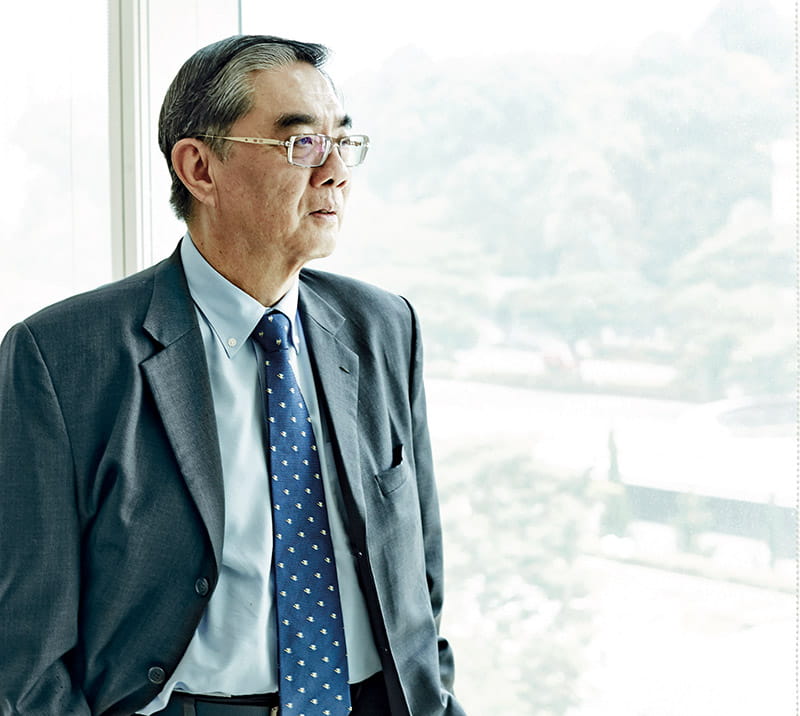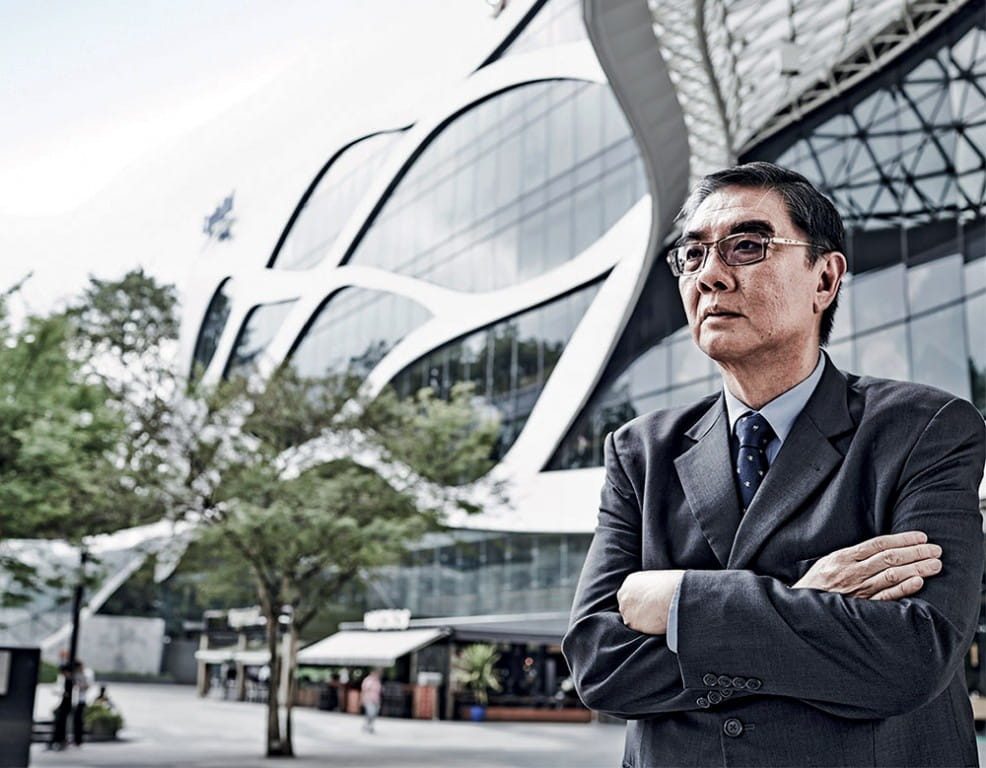Stories > The Art Of Tact
The Art Of Tact

Ambassador Ong Keng Yong is down-to-earth and well-regarded, no matter which of his many hats of high office he wears. He shares the wisdom he gleaned from 37 years of bringing together different communities to cooperate on global issues.
BY ONG SOH CHIN
PHOTO JUSTIN LOH
veteran of Singapore’s diplomatic corps since 1979, Ambassador Ong Keng Yong made his mark securing for Singapore the global recognition and good ties with the international community that the young nation needed to survive. Today, he is Ambassador-at-Large at Singapore’s Ministry of Foreign Affairs, non-resident High Commissioner to Pakistan and non-resident Ambassador to Iran.
Ambassador Ong holds a law degree from the then-University of Singapore and a Master of Arts in Arab Studies from Georgetown University in the United States. He was previously the high commissioner of Singapore to Malaysia from 2011 to 2014. He was also the secretary-general of Asean from January 2003 to January 2008, during which time he was based in Jakarta, Indonesia.
He is currently the executive deputy chairman of the S. Rajaratnam School of International Studies at the Nanyang Technological University in Singapore and also the chairman of the Singapore International Foundation, a post he assumed in April 2015.
He has a wealth of experience from his many diplomatic postings, earning for Singapore the friendship, goodwill and support of numerous governments and prominent figures within the international community. Among his chief traits are humility and a strong sense of duty.
“Every Singaporean is an ambassador of Singapore. We need the efforts of all to achieve our goal of becoming a nation of responsible global citizens. I think this is what the next stage of Singaporeʼs development should be focused on.”
Ong Keng Yong, Ambassador-at-Large
Early in his career, he earned a reputation for being fair and compassionate. He says: "When I was a young civil servant, I had a philosophy which I shared with my seniors. I said that if I can make someone happy by doing something, I'll do it."

Ambassador Ong Keng Yong draws on his vast diplomatic experience to get different communities to work together towards common goals.
1. Much of your work involves enhancing the ties between Singapore and the international community. How has this shaped your perspectives of life, values and the global community at large?
I have found that everywhere I go, regardless of culture or country, people are concerned with working hard so as to improve the lives of their children and family.
Whenever I travel for work and meet kids on the street peddling little keychains or soft drinks, I would not hesitate to buy something from them. Just doing a little bit can make a big difference in their lives.
2. Could you share some examples of the friendships you have forged with international leaders and captains of industries over the course of your diplomatic career? Which ones made the strongest impression?
Over the course of my career, I have built rapport and developed mutual trust and friendships with many of my international counterparts. Many are on speed dial on my handphone, and I truly appreciate their prompt responses when approached. For instance, I recently spoke to the former foreign minister of Indonesia, Hassan Wirajuda, on his personal handphone. I read these simple gestures positively.
It has been my privilege to count many colleagues in the diplomatic circles as friends. I used to work very closely with Rafidah Aziz, the former Malaysian minister for trade and industry. She would always tease me about being too serious. Once, she asked why I never played golf. I explained that since she was a minister while I was only a secretary-general (of Asean), if I played golf with her, all the Asean director-generals would have to do so with everybody else.
She understood where I was coming from. Later, when I became the high commissioner to Malaysia, she would invite me to sit with her whenever we met at conferences.
3. In your role as secretary-general of Asean, what were some of your challenges and most vivid memories?
Diversity, as much as it is a blessing, can more often than not, add a lot of colour to a situation. Once, when we were discussing the draft for the Asean charter, we had 10 countries bargaining and trying to strike out sentences or insert their preferred words. We eventually got to a point where the whole document was a mess, full of amendments and corrections
As secretary-general, I calmly clicked the “accept all changes” button on the computer and asked everyone if that was what they wanted the final document to look like. Someone then said, “Secretary-General, this is rojak (rojak means an eclectic mix in colloquial Malay)!” I replied that everyone involved was responsible for that. It made them realise that they had to manage and balance a multitude of diverse views to reach a consensus. In the end, the document was sent back and edited with agreement from all the parties involved.
4. How is Singapore perceived in Asean?
Singapore’s stability has been defined by the successful relationships it has built with its Asean neighbours. We are taken seriously by everyone and treated with a great deal of respect. I credit that to us being practical people, and having the ability to come up with concrete suggestions to solve a problem or resolve a dispute. Our facility with the English language has also helped us in getting straight to the point, articulating the situation and addressing the challenges.
5. What part can Singapore play in the Asean Community Vision 2025?
Everyone in South-east Asia acknowledges Singapore as a success story. We have no other resources except for our people. When we say we want to help build capacity in countries like Myanmar, Laos or Cambodia, it’s believable because we have gone through this journey and shown that we can produce results which contribute to economic progress. Our contribution will really be in showing that things are possible and passing on what we have experienced to others. We can build on this, to work with and make the most of the different strengths of each member country. We can promote this concept of connectivity across all the Asean countries.
6. What is your vision for Singapore within the Asean community?
Singapore aims to be relevant and useful to the world. People see us as being very business-like. In everything that we do, we would like to see a return on dividends. But sometimes, these dividends cannot come about immediately, especially in human capital and human resource development. For example, Asean students enrol in our secondary schools, high schools and universities. By the time they graduate and go into the job market, it would have been at least 10 to 15 years before they have started contributing to the Singapore economy. We have to be a bit more generous with time and in spirit, as well as in terms of resource mobilisation.
7. How successful has Singapore been in plugging into the global stage and being a responsible global citizen? What more can be done to connect Singapore with the global community?
Lee Kuan Yew always believed we had to make a difference and distinguish ourselves to stand out. He said we had to make Singapore an oasis in the desert, and that’s what we have been doing. I think we have accomplished that after 50 years.
Now, going forward, in order to be regarded as a mature country with a responsible leadership, we have to be more international in our outlook. If you are an oasis, you are supposed to provide water to every fellow traveller passing through.
Every Singaporean is an ambassador of Singapore. We need the efforts of all to achieve our goal of becoming a nation of responsible global citizens. I think this is what the next stage of Singapore’s development should be focused on.
8. How can we encourage more Singaporeans to actively step up to this role of becoming better citizen ambassadors?
Our responsibility should go beyond just helping out once and then saying our work is done. We should continue to help build on what we started and ensure sustainability. If you go to Japan today, to places affected by the 3/11 tsunami, there are community facilities with the Singapore name on them. Similarly, in Aceh, Indonesia, you can find post-disaster reconstructed mosques, orphanages and schools linked to Singapore. It will be good for us to keep in touch with them and render assistance where needed.
9. What is your most effective diplomatic tool? Can one learn diplomacy or is it an innate ability?
When I was secretary-general of Asean, there were 10 countries and, therefore, 10 different positions. So I would always remind them that if we did not resolve an issue by the end of the day, we would have to return the next morning and start again from the same point. My basic approach was to always try to move forward a little bit. If we can move forward more than a little bit, that’s better. But if we cannot, then we should start tomorrow not where we are today. That has been my approach.
10. What is the heart and soul of Singapore? How should we protect and nurture it?
There is no concrete definition and I think we should avoid trying to find one. What is important is that we must be able to feel for our fellow citizens, our neighbours and other human beings beyond our national boundaries. We may be very modern and very advanced in technology, and we sometimes come across as being impatient and business-like, but, at the end of the day, we are still moved by simple tragic situations and are compelled to help. This is the heart and soul of Singapore but it cannot be described in black and white.
